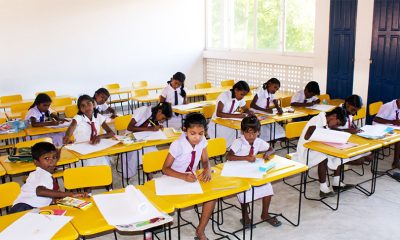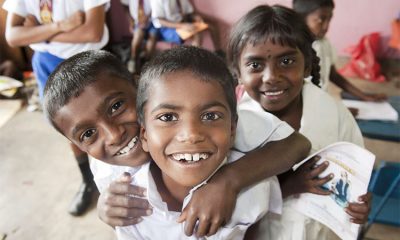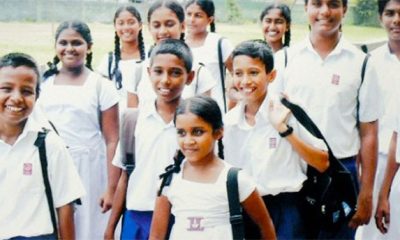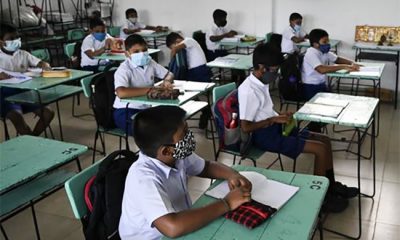Features
Gender and sexuality in the classroom

by Mahendran Thiruvarangan
 The classroom is believed to be a site that nourishes scholarship, diversity, creativity and dissent. It should facilitate students and teachers of diverse genders and sexual preferences to live out their identities, if they wish to, without hindrance. However, in reality, the classroom, in Sri Lanka, remains a microcosm of the larger society and often re-produces the social hierarchies of gender and sexuality. One’s body, expressions and desires are policed heavily in this space through unwritten codes of conduct entrenched in discourses of gender and sexual normativity. Today’s Kuppi Talk explores how the classroom in the Sri Lankan context remains a space that marginalizes women and LGBTIQ+ persons and what needs to be done to make this space more inclusive.
The classroom is believed to be a site that nourishes scholarship, diversity, creativity and dissent. It should facilitate students and teachers of diverse genders and sexual preferences to live out their identities, if they wish to, without hindrance. However, in reality, the classroom, in Sri Lanka, remains a microcosm of the larger society and often re-produces the social hierarchies of gender and sexuality. One’s body, expressions and desires are policed heavily in this space through unwritten codes of conduct entrenched in discourses of gender and sexual normativity. Today’s Kuppi Talk explores how the classroom in the Sri Lankan context remains a space that marginalizes women and LGBTIQ+ persons and what needs to be done to make this space more inclusive.
Seeming Neutrality
Teachers and students, who belong to privileged groups and classes, view the classroom as a neutral space. Many of us tend to assume that interactions that happen in the classroom are unaffected by gender-based hierarchies. In academic institutions, heterosexuality is normativized and desires and relationships that fall outside heterosexuality are stigmatized as abnormal, abusive, Western and anti-social. In these spaces, expectations, related to attire, appearance and behaviour, stem from the understanding that there are only two genders – male and female. These expectations imply that the boundaries that separate the two genders are inviolable, and that masculinity and femininity are homogenous expressions unmediated by personal preferences, culture, ethnicity, religion and class.
While physical infrastructure, such as gender-specific staff rooms and bathrooms sometimes provide comfort and security for female students and teachers, such divisions are naturalized and result in the binaristic reification of gender and exclusion of transgenders. Many schools in Sri Lanka still remain uninitiated to conversations about sexual and gender diversity. As a result, adolescents who experience sexual preferences that do not align with cis-hetero norms go through immense agony, their struggles remaining hidden and unrecognized in policy-making.
Invisibility
The cis-heteronormative structures that operate within the classroom prevent LGBTIQ+ persons from expressing their identities openly. They fear facing stigma and isolation, if they openly discuss their identities, desires and preferences.
Thanks to efforts taken in the public sphere to combat homophobia and transphobia, there is an increased number of students and teachers, within our institutions, who openly identify as LGBTIQ persons today. While this is a welcome change, the flipside of such liberating articulations of sexuality is that the rest of the classroom is assumed to be heterosexual and cis-gender. Even as we strive for inclusivity, we have to keep in mind that all genders/sexual orientations are not equally visible. Teachers and students tend to assume that there are no or only a few LGBTIQ+ persons in their classrooms or institutions, whereas the actual numbers can be higher.
Even in the absence of any open signs of LGBTIQ+ presence then, we need to re-create the classroom as a safe and inclusive place for LGBTIQ+ persons. There is a need to assume that there is always someone waiting for safety, solidarity, comfort and acceptance in the classroom, even if that person does not want to express their sexual preferences, or gender, openly.
The Curriculum
The curriculum is an arena where questioning of cis-hetero normativity can be encouraged. An LGBTIQ-friendly curriculum has the potential to make LGBTIQ+ students find acceptance in the classroom and encourage them to engage in academic conversations about their identities, lives, experiences and struggles without any inhibition. The empowerment that happens via an inclusive curriculum may help these students navigate and resist the heteronormative structures that they encounter in their everyday lives, outside the academia.
The curriculum taught as part of different academic programmes, at our universities today, include one or two courses that focus on gender and sexuality. Sometimes these courses frame gender in narrow terms placing the cis-heterosexual woman as the only figure that merits academic attention. They do not give adequate room for discussions on how gender and sexuality are intertwined. Sometimes they are offered as elective courses and only those interested in the theme of gender (and sexuality) sign up for those courses. As a result, majority of our students may graduate without sufficient exposure to academic conversations related to gender and sexuality. Even these elective courses are sometimes not thought through well, and introduced in a haphazard manner merely to satisfy the diversity requirement included in policy frameworks.
Under neoliberalization of education, the inclusion of gender in the curriculum is reduced to a process of representing different gendered experiences. While representation is important, it cannot be isolated from the contexts associated with the gendered student, the economic and political systems that the gendered student is part of, and the systems of gendering and power that are at play. Neoliberalism has co-opted the discourse of gender diversity to achieve its own ends. It is now actively involved in producing marketable female graduates and possibly marketable LGBTIQ+ graduates, too. This is why gender and cultural diversity in the curriculum should be sutured to questions about political economy, class relations and material inequalities. An intersectional approach that questions and goes beyond notions of employable female graduates and women entrepreneurs should shape the larger social vision offered via the curriculum.
While the inclusion of courses with specific focus on gender diversifies the curriculum, such courses sometimes curtail our understanding of the way gender operates in society and within the workings of various academic disciplines. While these courses bring questions related to gender and sexuality to the front and centre, they may simultaneously create the false picture that the other courses are gender-neutral or gender inclusive. Therefore, one must ask to what extent the courses, which are not specifically about gender, shift emphasis towards women and LGBITQ+ persons. It is important that we understand gender and sexuality as concerns that run throughout what we teach. For example, a course with a focus on class relations should discuss how class relations are gendered and the ways in which gender and sexuality inflect political economy and material-based social relations. It is important to frame the entire curriculum as a site where a struggle for justice for the historical exclusion that women and LGBTIQ+ communities have suffered can be mounted. Given the historical dominance of heteronormativity within the academia, the curriculum as a whole should be revamped and re-vitalized from the vantagepoint of women and LGBTIQ+ persons.
Pedagogy
Teaching against cis-heteronormativity faces resistance, not just from institutional policies and restrictions imposed by the curriculum, but also from students. When I taught an English translation of Ismat Chugtai’s “Lihaaf”, a text that reveals how power operating along lines of socio-economic status produces relations and intimacy between women as a messy terrain of dominance, subversion, resistance and manipulation, a section of the students denounced the text as one that promotes ‘lesbianism’. On such occasions, it is incumbent upon the teacher to trigger processes of self-introspection so that the cis-straight student is encouraged to question the privileges and comforts that the student has taken for granted under a heteronormative social order.
On the other hand, the discussion, as in the case of Chugtai’s text, should orient the student to the understanding that sexual relations, regardless of whether they are straight or gay, are often inflected by power manifesting itself through the axes of class, ethnicity and caste and that non-heterosexual relations are not free of control and manipulation. This is why an emancipating pedagogy should give a central place to not just empathy and solidarity but also critical interrogation of power in gendered relations of all kinds.
While the Sri Lankan classroom has a long way to go to become a place that embraces gender and sexual diversity, we have seen moments of hope as well. In many academic departments, undergraduates, who do their research on LGBTIQ+ issues, find increased encouragement and support from academics. Some of our universities have provided their venues for discussions, cultural festivals and awareness raising events focusing on LGBTIQ+ communities. There have been instances where students came together to support and stand in solidarity with students of marginalized genders and sexual orientations when the latter faced hostilities in hostels and classrooms. It is important that we sustain, strengthen and build on these changes.
The classroom should not remain isolated from the larger struggles around gender and LGBTIQ issues. The favourable Supreme Court decision on the recent Bill to repeal Article 365, the Pride events that took place in Jaffna and Colombo last year, and the gains made by the LGBITQ communities in their various struggles for equality should encourage the academic community to take forward, with more enthusiasm, the task of making our free education sector more inclusive and democratic. This task also requires our willingness to de-centre the academia and learn from how working women and LGBTIQ+ persons from subaltern, minority, peripheral, oppressed caste communities resist male chauvinism and cis-heteronormativity alongside their everyday struggles against capitalist exploitation and ethnic and caste-based oppression.
(Mahendran Thiruvarangan is a Senior Lecturer attached to the Department of Linguistics and English at the University of Jaffna)
Kuppi is a politics and pedagogy happening on the margins of the lecture hall that parodies, subverts, and simultaneously reaffirms social hierarchies.
Features
The heart-friendly health minister

by Dr Gotabhya Ranasinghe
Senior Consultant Cardiologist
National Hospital Sri Lanka
When we sought a meeting with Hon Dr. Ramesh Pathirana, Minister of Health, he graciously cleared his busy schedule to accommodate us. Renowned for his attentive listening and deep understanding, Minister Pathirana is dedicated to advancing the health sector. His openness and transparency exemplify the qualities of an exemplary politician and minister.
Dr. Palitha Mahipala, the current Health Secretary, demonstrates both commendable enthusiasm and unwavering support. This combination of attributes makes him a highly compatible colleague for the esteemed Minister of Health.
Our discussion centered on a project that has been in the works for the past 30 years, one that no other minister had managed to advance.
Minister Pathirana, however, recognized the project’s significance and its potential to revolutionize care for heart patients.
The project involves the construction of a state-of-the-art facility at the premises of the National Hospital Colombo. The project’s location within the premises of the National Hospital underscores its importance and relevance to the healthcare infrastructure of the nation.
This facility will include a cardiology building and a tertiary care center, equipped with the latest technology to handle and treat all types of heart-related conditions and surgeries.
Securing funding was a major milestone for this initiative. Minister Pathirana successfully obtained approval for a $40 billion loan from the Asian Development Bank. With the funding in place, the foundation stone is scheduled to be laid in September this year, and construction will begin in January 2025.
This project guarantees a consistent and uninterrupted supply of stents and related medications for heart patients. As a result, patients will have timely access to essential medical supplies during their treatment and recovery. By securing these critical resources, the project aims to enhance patient outcomes, minimize treatment delays, and maintain the highest standards of cardiac care.
Upon its fruition, this monumental building will serve as a beacon of hope and healing, symbolizing the unwavering dedication to improving patient outcomes and fostering a healthier society.We anticipate a future marked by significant progress and positive outcomes in Sri Lanka’s cardiovascular treatment landscape within the foreseeable timeframe.
Features
A LOVING TRIBUTE TO JESUIT FR. ALOYSIUS PIERIS ON HIS 90th BIRTHDAY

by Fr. Emmanuel Fernando, OMI
Jesuit Fr. Aloysius Pieris (affectionately called Fr. Aloy) celebrated his 90th birthday on April 9, 2024 and I, as the editor of our Oblate Journal, THE MISSIONARY OBLATE had gone to press by that time. Immediately I decided to publish an article, appreciating the untiring selfless services he continues to offer for inter-Faith dialogue, the renewal of the Catholic Church, his concern for the poor and the suffering Sri Lankan masses and to me, the present writer.
It was in 1988, when I was appointed Director of the Oblate Scholastics at Ampitiya by the then Oblate Provincial Fr. Anselm Silva, that I came to know Fr. Aloy more closely. Knowing well his expertise in matters spiritual, theological, Indological and pastoral, and with the collaborative spirit of my companion-formators, our Oblate Scholastics were sent to Tulana, the Research and Encounter Centre, Kelaniya, of which he is the Founder-Director, for ‘exposure-programmes’ on matters spiritual, biblical, theological and pastoral. Some of these dimensions according to my view and that of my companion-formators, were not available at the National Seminary, Ampitiya.
Ever since that time, our Oblate formators/ accompaniers at the Oblate Scholasticate, Ampitiya , have continued to send our Oblate Scholastics to Tulana Centre for deepening their insights and convictions regarding matters needed to serve the people in today’s context. Fr. Aloy also had tried very enthusiastically with the Oblate team headed by Frs. Oswald Firth and Clement Waidyasekara to begin a Theologate, directed by the Religious Congregations in Sri Lanka, for the contextual formation/ accompaniment of their members. It should very well be a desired goal of the Leaders / Provincials of the Religious Congregations.
Besides being a formator/accompanier at the Oblate Scholasticate, I was entrusted also with the task of editing and publishing our Oblate journal, ‘The Missionary Oblate’. To maintain the quality of the journal I continue to depend on Fr. Aloy for his thought-provoking and stimulating articles on Biblical Spirituality, Biblical Theology and Ecclesiology. I am very grateful to him for his generous assistance. Of late, his writings on renewal of the Church, initiated by Pope St. John XX111 and continued by Pope Francis through the Synodal path, published in our Oblate journal, enable our readers to focus their attention also on the needed renewal in the Catholic Church in Sri Lanka. Fr. Aloy appreciated very much the Synodal path adopted by the Jesuit Pope Francis for the renewal of the Church, rooted very much on prayerful discernment. In my Religious and presbyteral life, Fr.Aloy continues to be my spiritual animator / guide and ongoing formator / acccompanier.
Fr. Aloysius Pieris, BA Hons (Lond), LPh (SHC, India), STL (PFT, Naples), PhD (SLU/VC), ThD (Tilburg), D.Ltt (KU), has been one of the eminent Asian theologians well recognized internationally and one who has lectured and held visiting chairs in many universities both in the West and in the East. Many members of Religious Congregations from Asian countries have benefited from his lectures and guidance in the East Asian Pastoral Institute (EAPI) in Manila, Philippines. He had been a Theologian consulted by the Federation of Asian Bishops’ Conferences for many years. During his professorship at the Gregorian University in Rome, he was called to be a member of a special group of advisers on other religions consulted by Pope Paul VI.
Fr. Aloy is the author of more than 30 books and well over 500 Research Papers. Some of his books and articles have been translated and published in several countries. Among those books, one can find the following: 1) The Genesis of an Asian Theology of Liberation (An Autobiographical Excursus on the Art of Theologising in Asia, 2) An Asian Theology of Liberation, 3) Providential Timeliness of Vatican 11 (a long-overdue halt to a scandalous millennium, 4) Give Vatican 11 a chance, 5) Leadership in the Church, 6) Relishing our faith in working for justice (Themes for study and discussion), 7) A Message meant mainly, not exclusively for Jesuits (Background information necessary for helping Francis renew the Church), 8) Lent in Lanka (Reflections and Resolutions, 9) Love meets wisdom (A Christian Experience of Buddhism, 10) Fire and Water 11) God’s Reign for God’s poor, 12) Our Unhiddden Agenda (How we Jesuits work, pray and form our men). He is also the Editor of two journals, Vagdevi, Journal of Religious Reflection and Dialogue, New Series.
Fr. Aloy has a BA in Pali and Sanskrit from the University of London and a Ph.D in Buddhist Philosophy from the University of Sri Lankan, Vidyodaya Campus. On Nov. 23, 2019, he was awarded the prestigious honorary Doctorate of Literature (D.Litt) by the Chancellor of the University of Kelaniya, the Most Venerable Welamitiyawe Dharmakirthi Sri Kusala Dhamma Thera.
Fr. Aloy continues to be a promoter of Gospel values and virtues. Justice as a constitutive dimension of love and social concern for the downtrodden masses are very much noted in his life and work. He had very much appreciated the commitment of the late Fr. Joseph (Joe) Fernando, the National Director of the Social and Economic Centre (SEDEC) for the poor.
In Sri Lanka, a few religious Congregations – the Good Shepherd Sisters, the Christian Brothers, the Marist Brothers and the Oblates – have invited him to animate their members especially during their Provincial Congresses, Chapters and International Conferences. The mainline Christian Churches also have sought his advice and followed his seminars. I, for one, regret very much, that the Sri Lankan authorities of the Catholic Church –today’s Hierarchy—- have not sought Fr.
Aloy’s expertise for the renewal of the Catholic Church in Sri Lanka and thus have not benefited from the immense store of wisdom and insight that he can offer to our local Church while the Sri Lankan bishops who governed the Catholic church in the immediate aftermath of the Second Vatican Council (Edmund Fernando OMI, Anthony de Saram, Leo Nanayakkara OSB, Frank Marcus Fernando, Paul Perera,) visited him and consulted him on many matters. Among the Tamil Bishops, Bishop Rayappu Joseph was keeping close contact with him and Bishop J. Deogupillai hosted him and his team visiting him after the horrible Black July massacre of Tamils.
Features
A fairy tale, success or debacle

Sri Lanka-Singapore Free Trade Agreement
By Gomi Senadhira
senadhiragomi@gmail.com
“You might tell fairy tales, but the progress of a country cannot be achieved through such narratives. A country cannot be developed by making false promises. The country moved backward because of the electoral promises made by political parties throughout time. We have witnessed that the ultimate result of this is the country becoming bankrupt. Unfortunately, many segments of the population have not come to realize this yet.” – President Ranil Wickremesinghe, 2024 Budget speech
Any Sri Lankan would agree with the above words of President Wickremesinghe on the false promises our politicians and officials make and the fairy tales they narrate which bankrupted this country. So, to understand this, let’s look at one such fairy tale with lots of false promises; Ranil Wickremesinghe’s greatest achievement in the area of international trade and investment promotion during the Yahapalana period, Sri Lanka-Singapore Free Trade Agreement (SLSFTA).
It is appropriate and timely to do it now as Finance Minister Wickremesinghe has just presented to parliament a bill on the National Policy on Economic Transformation which includes the establishment of an Office for International Trade and the Sri Lanka Institute of Economics and International Trade.
Was SLSFTA a “Cleverly negotiated Free Trade Agreement” as stated by the (former) Minister of Development Strategies and International Trade Malik Samarawickrama during the Parliamentary Debate on the SLSFTA in July 2018, or a colossal blunder covered up with lies, false promises, and fairy tales? After SLSFTA was signed there were a number of fairy tales published on this agreement by the Ministry of Development Strategies and International, Institute of Policy Studies, and others.
However, for this article, I would like to limit my comments to the speech by Minister Samarawickrama during the Parliamentary Debate, and the two most important areas in the agreement which were covered up with lies, fairy tales, and false promises, namely: revenue loss for Sri Lanka and Investment from Singapore. On the other important area, “Waste products dumping” I do not want to comment here as I have written extensively on the issue.
1. The revenue loss
During the Parliamentary Debate in July 2018, Minister Samarawickrama stated “…. let me reiterate that this FTA with Singapore has been very cleverly negotiated by us…. The liberalisation programme under this FTA has been carefully designed to have the least impact on domestic industry and revenue collection. We have included all revenue sensitive items in the negative list of items which will not be subject to removal of tariff. Therefore, 97.8% revenue from Customs duty is protected. Our tariff liberalisation will take place over a period of 12-15 years! In fact, the revenue earned through tariffs on goods imported from Singapore last year was Rs. 35 billion.
The revenue loss for over the next 15 years due to the FTA is only Rs. 733 million– which when annualised, on average, is just Rs. 51 million. That is just 0.14% per year! So anyone who claims the Singapore FTA causes revenue loss to the Government cannot do basic arithmetic! Mr. Speaker, in conclusion, I call on my fellow members of this House – don’t mislead the public with baseless criticism that is not grounded in facts. Don’t look at petty politics and use these issues for your own political survival.”
I was surprised to read the minister’s speech because an article published in January 2018 in “The Straits Times“, based on information released by the Singaporean Negotiators stated, “…. With the FTA, tariff savings for Singapore exports are estimated to hit $10 million annually“.
As the annual tariff savings (that is the revenue loss for Sri Lanka) calculated by the Singaporean Negotiators, Singaporean $ 10 million (Sri Lankan rupees 1,200 million in 2018) was way above the rupees’ 733 million revenue loss for 15 years estimated by the Sri Lankan negotiators, it was clear to any observer that one of the parties to the agreement had not done the basic arithmetic!
Six years later, according to a report published by “The Morning” newspaper, speaking at the Committee on Public Finance (COPF) on 7th May 2024, Mr Samarawickrama’s chief trade negotiator K.J. Weerasinghehad had admitted “…. that forecasted revenue loss for the Government of Sri Lanka through the Singapore FTA is Rs. 450 million in 2023 and Rs. 1.3 billion in 2024.”
If these numbers are correct, as tariff liberalisation under the SLSFTA has just started, we will pass Rs 2 billion very soon. Then, the question is how Sri Lanka’s trade negotiators made such a colossal blunder. Didn’t they do their basic arithmetic? If they didn’t know how to do basic arithmetic they should have at least done their basic readings. For example, the headline of the article published in The Straits Times in January 2018 was “Singapore, Sri Lanka sign FTA, annual savings of $10m expected”.
Anyway, as Sri Lanka’s chief negotiator reiterated at the COPF meeting that “…. since 99% of the tariffs in Singapore have zero rates of duty, Sri Lanka has agreed on 80% tariff liberalisation over a period of 15 years while expecting Singapore investments to address the imbalance in trade,” let’s turn towards investment.
Investment from Singapore
In July 2018, speaking during the Parliamentary Debate on the FTA this is what Minister Malik Samarawickrama stated on investment from Singapore, “Already, thanks to this FTA, in just the past two-and-a-half months since the agreement came into effect we have received a proposal from Singapore for investment amounting to $ 14.8 billion in an oil refinery for export of petroleum products. In addition, we have proposals for a steel manufacturing plant for exports ($ 1 billion investment), flour milling plant ($ 50 million), sugar refinery ($ 200 million). This adds up to more than $ 16.05 billion in the pipeline on these projects alone.
And all of these projects will create thousands of more jobs for our people. In principle approval has already been granted by the BOI and the investors are awaiting the release of land the environmental approvals to commence the project.
I request the Opposition and those with vested interests to change their narrow-minded thinking and join us to develop our country. We must always look at what is best for the whole community, not just the few who may oppose. We owe it to our people to courageously take decisions that will change their lives for the better.”
According to the media report I quoted earlier, speaking at the Committee on Public Finance (COPF) Chief Negotiator Weerasinghe has admitted that Sri Lanka was not happy with overall Singapore investments that have come in the past few years in return for the trade liberalisation under the Singapore-Sri Lanka Free Trade Agreement. He has added that between 2021 and 2023 the total investment from Singapore had been around $162 million!
What happened to those projects worth $16 billion negotiated, thanks to the SLSFTA, in just the two-and-a-half months after the agreement came into effect and approved by the BOI? I do not know about the steel manufacturing plant for exports ($ 1 billion investment), flour milling plant ($ 50 million) and sugar refinery ($ 200 million).
However, story of the multibillion-dollar investment in the Petroleum Refinery unfolded in a manner that would qualify it as the best fairy tale with false promises presented by our politicians and the officials, prior to 2019 elections.
Though many Sri Lankans got to know, through the media which repeatedly highlighted a plethora of issues surrounding the project and the questionable credentials of the Singaporean investor, the construction work on the Mirrijiwela Oil Refinery along with the cement factory began on the24th of March 2019 with a bang and Minister Ranil Wickremesinghe and his ministers along with the foreign and local dignitaries laid the foundation stones.
That was few months before the 2019 Presidential elections. Inaugurating the construction work Prime Minister Ranil Wickremesinghe said the projects will create thousands of job opportunities in the area and surrounding districts.
The oil refinery, which was to be built over 200 acres of land, with the capacity to refine 200,000 barrels of crude oil per day, was to generate US$7 billion of exports and create 1,500 direct and 3,000 indirect jobs. The construction of the refinery was to be completed in 44 months. Four years later, in August 2023 the Cabinet of Ministers approved the proposal presented by President Ranil Wickremesinghe to cancel the agreement with the investors of the refinery as the project has not been implemented! Can they explain to the country how much money was wasted to produce that fairy tale?
It is obvious that the President, ministers, and officials had made huge blunders and had deliberately misled the public and the parliament on the revenue loss and potential investment from SLSFTA with fairy tales and false promises.
As the president himself said, a country cannot be developed by making false promises or with fairy tales and these false promises and fairy tales had bankrupted the country. “Unfortunately, many segments of the population have not come to realize this yet”.
(The writer, a specialist and an activist on trade and development issues . )




















